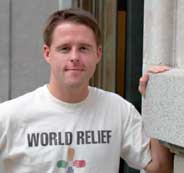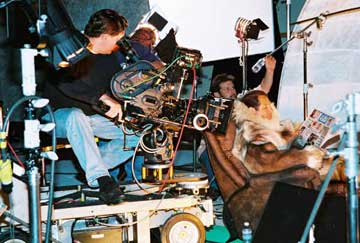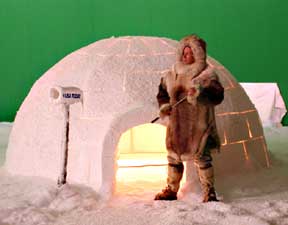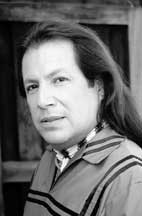|
|
Wired
My Short Life in Television
by Matthew Pugh
Discovered boxing in a gym, Pugh has savored his 15 seconds of fame
It’s 4am. Beneath elevated train tracks at the corner of North Washington and East Biddle Street on Baltimore’s East Side, the crew is preparing a series of shots.
Lights are strategically placed to bring the scene to life: around corners, behind buildings and even under the overpass to mimic the electrical sparks that emanate from the tracks.
The overpass helps create the illusion of Chicago. Adding to the effect are two Baltimore police cruisers made over with Illinois tags and a Chicago Tribune paper box stationed in the foreground.
Before humans step into their roles comes the legion of meticulous imagined details that create a set’s accuracy and continuity. We extras wait and wait. Ten long hours after our call, the director shuffles us to our spots. A burst of adrenaline breaks the spell of boredom and exhaustion.
“I want you to stand here, turn your head like this, your body like this, and don’t look at the camera,” she says. “Oh yeah, act naturally.”
 |
| Boxing one afternoon at the Baltimore Boxing Club in Fells Point, writer Matthew Pugh was ‘discovered,’ leading to brief appearances as an extra in two episodes of HBO’s Baltimore-based police-crime drama, The Wire. |
Like a captain drilling soldiers, the director runs cast and crew through dozens of rehearsals.
Finally, we’re all on the right page. Lights, cameras and sound systems are functioning.
“Camera,” the director prompts.
“Rolling,” the cameraman replies.
“Sound,” the director invokes.
“Sound, speed,” the operator replies, holding his headphones.
“Marker,” the director orders.
Snap, goes the marker.
“And, action …”
Cut!
Suddenly, out of the shadows, a Baltimore local — dressed in nightgown, slippers and curlers in her hair, smoking a cigarette and downing a carton of OJ — steps into the scene.
“Whatcha all filmin’?” she belts out in thick B-moreese.
“Cut!” the director barks.
A pair of Baltimore cops escort the visitor down the street, explaining that she has stumbled onto the set of the new HBO series The Wire.
Shot entirely in the Baltimore area, The Wire takes a Hollywood look at the war on drugs from the law’s side and the dealers’ side.
The 13-episode series begins as Homicide Detective Jimmy McNulty (Dominic West) witnesses another sure-conviction murder case get beaten. McNulty believes the case is related to a string of other murders that have gone unpunished due to a local drug gang’s intimidation.
After listening to McNulty’s grievances, the presiding judge contacts the deputy commissioner (Frankie R. Faison). The commissioner then calls McNulty’s boss, Major William Rawls (John Doman), making the police look inept.
To appease the judge and the commissioner, a joint homicide/narcotics investigation is created. Their target is drug kingpin Avon Barksdale (Wood Harris).
The Wire was created and is produced by Baltimore’s own David Simon (Homicide: Life on the Street) and co-produced by Robert Colesberry (K-Pax) and Nina Kostrof-Noble. The three are the creative team behind the Emmy Award winning miniseries The Corner.
“David has had a tremendous impact on this city,” said Jack Gerbes, director of the Maryland Film Office.
 Gerbes explained that when Simon’s book, Homicide, hit television, it put Baltimore on the map. Simon’s latest contributions, The Corner and The Wire, nurtured a strong relationship between HBO and the state of Maryland. Gerbes explained that when Simon’s book, Homicide, hit television, it put Baltimore on the map. Simon’s latest contributions, The Corner and The Wire, nurtured a strong relationship between HBO and the state of Maryland.
“When it comes to Baltimore, Simon is to television what Barry Levinson and John Waters are to film,” said Gerbes.
Production on The Wire began in February and wrapped the first week of August.
Dealing with pushy city locals is to be expected. Interruptions are inevitable. Frustrating as they are to the crew, who are forced to set up retakes, they often bring moments of comic relief.
Discovered
As an extra, I don’t mind retakes. They freshen the anticipation of a possible appearance. We all share the dream of an appearance that evolves into mega-stardom. My dream began the day I was discovered by the folks at The Wire.
I was boxing on a May afternoon at Baltimore Boxing Club on South Broadway, Fells Point. The crew from The Wire was shooting at The Ritz Cabaret two doors down.
The speed bag was getting a good pummeling from me until a Wire sound tech interrupted.
“Hey Rocky: Could you chill out on the bag for a minute?” she asked. “Our mikes are picking up the thuds.”
Midway through the conversation that followed, I wondered if The Wire was looking for actors.
“Stop at The Ritz,” she said, “and see the big guy standing in front of the door.”
Pumped up and sweaty, off I went to see the big guy.
The guy was huge, and I was sheepish as I asked my question.
He gave me the once-over through his mirrored shades, cracked half a grin, handed me a bluecard and a pen and motioned for me to fill it out.
Then, he raised up a Polaroid camera hidden in his massive hands, snapped my photo and tossed it and my bluecard into a box with a thousand other cards and photos.
“We’ll call you if we’re interested,” he said.
My dream of becoming a star was wrecked by his words. That’s a call I wasn’t counting on getting.
A month later, my phone rang. It was Pat Moran & Associates. The Wire’s casting company wondered if I wanted to be on HBO. They picked my bluecard and liked my photo.
Peter Gabriel’s song “Big Time” blared in my brain. I went from zero to 60 in a flash.
“You’re going to be playing a prisoner,” the casting associate said. “Report to the set at 10 in the morning.”
I couldn’t wait to go to jail.
Flashback
With the other prisoners, I was herded to wardrobe and fitted with a bright orange jumpsuit and blue slipper shoes. Then, together, we were corralled around the Crafts Services table on the stairs of the Mitchell Courthouse downtown.
Among the orange jumpsuits, I postured and flexed, hoping to make someone important notice me. Nobody noticed, so I stuffed my face.
The best part about working on a major television or film production is the food. Craft Services serves the all-day refreshments for cast and crew. Cinema Catering, out of Wilmington, N.C., provided the daily breakfast and late lunch — at a cost $5,000 a week.
A set’s full of hurry-up-and-wait. You always have to be ready to go. In 14 hours on set, I did one hour of work. But I didn’t mind the wait. Food helped fill the void.
I grazed on steaks, garlic mashed potatoes, Caesar salad, muffins, ice cream, cookies, trail mix, chips and salsa, pizza, bagels and candy.
My appetite nearly made me forget why I was there. Then Narcotics Detective Shamika Greggs (Sonja Sohn) strolled by, and I remembered.
Finally it was time to work. Inside the courthouse, we prisoners were sent to the pre-trial holding tank. Still determined to be noticed, I jumped into character, brooding around the fish bowl like a hardened criminal. My determination paid off.
The director, Brad Anderson, looked at me, said “hmmm,” stroked his chin and placed me directly in the shot. As envy rose from the other prisoners, I feared I might be shanked.
I survived another hour and a dozen takes before we wrapped Episode 10, “The Cost.”
 |
| Filming for The Wire at The Ritz Cabaret in Fell’s Point led to writer Pugh’s ‘discovery.’ |
Star Struck
My chances of becoming a star are slim, but you never know. That’s the exciting part. That excitement sticks to your ribs, like catered food.
My pulse raced when Episode 10 aired. I watched earnestly for my moment in the sun, still reeling about appearing on HBO.
The heart of Baltimore is reeling, too.
As a Baltimore City resident, I see The Wire’s set locations and much of the action portrayed in the show on a daily basis. Drug paraphernalia and litter are all-too-familiar sights on Baltimore’s streets.
From Lexington Market to Broadway Market, the projects behind North Eutaw Street to the projects on South Eden Street, you can see it all. Sadly, The Wire is art imitating the darker side of Baltimore life.
On the brighter side, The Wire hoists Baltimore higher up into the realm of cinematic cities like Los Angeles and the Big Apple, boosting Baltimore’s prominence. Simon and his stories have made the city famous to readers and television viewers around the country.
Streets lined with Italian brick and form-stone houses flash in the background of scene after scene, revealing Baltimore’s irresistible charm and personality. Skyline shots of Ravens Stadium and Camden Yards capture the city’s unrelenting spirit.
The Wire is a series about Baltimore, shot on location, and I can’t help feeling proud as I watch and wait for my 15 minutes of fame. Suddenly, the shot cuts to the Mitchell courthouse.
“Shush, here comes my scene,” I announce to my co-audience of one. I perch on the edge of my seat, my heart pounding. The camera pans right across the glass, and there I am in my glorious orange jumpsuit, turned to the side, miming expletives, acting like a prisoner.
There I am. And there I went. My 15 minutes was 15 seconds.
Still, I’m proud. Through television the experience is captured and encapsulated forever.
I figured my fame was a one-time deal and never counted on a second call. A month later, the phone rang. Pat Moran and Associates wondered if I wanted to be on HBO again.
Peter Gabriel’s “Big Time” blared in my brain. Again, I went from zero to 60 in a flash.
“You’re going to be playing a Chicago drug dealer on the 13th and final episode,” the casting associate said. “Report to the set of “The Sentencing” at five tomorrow night.”
I couldn’t wait to go to work.
For a rebroadcast schedule of The Wire, log on to www.HBO.com
| About the Author:
Former Bay Weekly intern Matthew Pugh now works as the Communications/Public Relations Associate for the humanitarian organization World Relief, in Baltimore.
|
 |
My Acting Dreams are Dusty
by Albert ‘Abby’ Ybarra
My Screen Actors Guild card has grown dusty. Once, acting was how I lived. Looking for one day of union work was a full-time job. But since I pitched my tent near the Bay, the irrelevant treatment that an actor or extra must endure had become a memory.
 Then I got a call from a local casting company for work on Chris Rock’s film Head of State. My call was 6am in downtown Baltimore. There a cast of hundreds piled into the hottest holding area that a location crew could find. With a sense of being rushed into the Roman arena, we piled into an old church to get our directions for the day. Then I got a call from a local casting company for work on Chris Rock’s film Head of State. My call was 6am in downtown Baltimore. There a cast of hundreds piled into the hottest holding area that a location crew could find. With a sense of being rushed into the Roman arena, we piled into an old church to get our directions for the day.
“Okay, listen up, people.” You hear that all day.
“If you are an extra, you eat your breakfast up here” — where, in the early morning, the heat was already stifling. “If you’re Union, then you can eat meals in the cast and crew section downstairs” — meaning real food and some air conditioning.
Again, I was glad that I still pay my union dues to remain active.
Experience has its rewards, for working on any production is a class struggle. First come lead actors with star names, then union actors and finally the extras. But the most important people on any film are production people, the PAs. They have two or three butt-packs full of stuff and headsets that they talk into incessantly. “Okay, people, listen up.”
Not looking like the rest of the cast, I was pegged as the Crying Indian. Remember him — Iron Eyes Cody?
I say in my most confident voice, “that’s the role I was sent here to do.”
“Oh, then you’re Union?”
If you sound like you know what you’re doing, that just may be so. They whisked me off to makeup and hair. Then another important production assistant saw me.
“Oh no, he has to go to the set trailer for hair, makeup and wardrobe.”
I was shuttled a few blocks to the set. There you see the huge trailer trucks that indicate a film is being made. After a few minutes in makeup and hair, they rush me over to wardrobe to try on Native American regalia. Time: 8am.
With my checklist finished, I was sent back to the hot church to hurry up and wait with the rest of the cast. This day they were doing interior shots of election-day celebrations, so only 150 extras were needed. As the morning wore on, the heat and humidity melted our makeup.
 |
| USA Today cast Native American Abby Ybarra as an Eskimo for a commercial to show that readers will find the paper everywhere. |
Finally the PAs yell the magic words: “We are moving to the set, people.” In a flash, I’m down the stairs and sitting in an air-conditioned rental van. After three vans fill, another PA yells out, “No! Not yet! We’re going back up to the holding area!”
One-hundred-fifty sweaty people tangled in the narrow stairs and in the street, wearing clothes set for “early fall-winter” on one of the hottest days of the summer.
Back we go, and an hour later they tell us to walk four blocks in the sweltering heat, while the PAs drive in the vans.
The set is a rented office building, and as we walk in, I hear comments from more important people, the set crew.
“Why are they here now?”
“Don’t worry,” says another. “They are just window dressing and will be out of sight real soon.”
“No, more like salad dressing,” I reply.
No response because the two camps — the PAs and the set crew — are sworn enemies. Cast and crew do not mingle or talk unless to berate us.
I get my direction from Chris Rock, who tells me not to smile.
Eventually, I shoot my scenes, and by noon we are released for lunch.
Our day ends at 6pm, when we hear the familiar words again. “Okay, people, listen up: you are now released.”
| About the Author:
Albert Ybarra, a descendent of Mexican Indian and Native American ancestors, has been an avid conservationist and environmental educator for many years, but he also has worn the hat of an actor from the age of five. Since moving to Chesapeake Beach two years ago, he has starred in a national commercial for USA Today and played a small role in the upcoming Chris Rock film Head of State.
|
 |
Copyright 2002
Bay Weekly
|